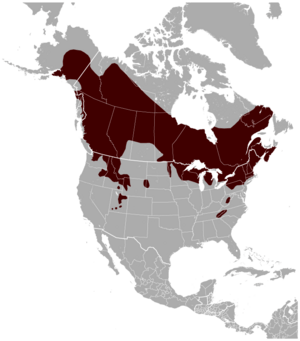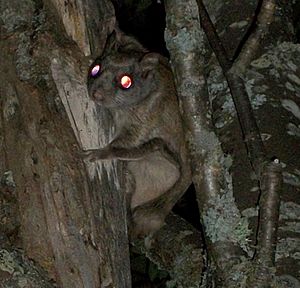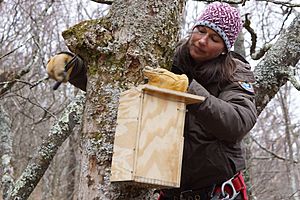Northern flying squirrel facts for kids
Quick facts for kids Northern flying squirrel |
|
|---|---|
 |
|
| Conservation status | |
| Scientific classification | |
| Genus: |
Glaucomys
|
| Species: |
sabrinus
|
| Subspecies | |
|
|
 |
|
| Northern flying squirrel range (modified) |
|
The northern flying squirrel (Glaucomys sabrinus) is a special type of flying squirrel found only in North America. These amazing creatures live in forests with pine and other mixed trees. You can find them across Canada, from Alaska to Nova Scotia. They also live south in the mountains of North Carolina and west to Utah in the United States.
Northern flying squirrels are light brown with pale fur on their bellies. They grow to be about 25 to 37 cm (10 to 15 in) long. While they are excellent gliders, they are not very good at walking on the ground. They eat many different things, like plants, tree sap, fungi, insects, and even bird eggs. Unlike most squirrels, they are active only at night.
Contents
Where Northern Flying Squirrels Live
Northern flying squirrels make their homes in coniferous and mixed forests. Their range stretches across the northern parts of North America. This includes places from Alaska all the way to Nova Scotia in Canada. In the United States, they live south in the mountains of North Carolina and Tennessee, and west to Utah.
Another type of flying squirrel, the Humboldt's flying squirrel, used to be thought of as the same species. However, scientists found they were actually a different, but very similar, species. The Humboldt's flying squirrel is usually smaller and darker. It lives in British Columbia, northern California, Washington, and Oregon.
Some northern flying squirrels in the southern Appalachian Mountains are considered endangered. These include the Carolina northern flying squirrel and the West Virginia northern flying squirrel. This means their numbers are very low, and they need protection.
What Northern Flying Squirrels Look Like
These squirrels are active at night and live in trees. They have thick, light brown or cinnamon fur on their backs. Their sides are greyish, and their undersides are white. They have big eyes, which help them see in the dark. Their tails are flat, and they have long whiskers. These whiskers are useful for finding their way around at night.
Adult northern flying squirrels are about 25 to 37 centimeters long. They usually weigh between 110 and 230 grams.
How Northern Flying Squirrels Glide
Northern flying squirrels don't truly fly like birds. Instead, they glide! They have a special flap of skin called a patagium that stretches between their front and back legs. When they want to glide, they climb to the top of a tree. They can start their glide by running or by just jumping off.
Before they jump, they often lean out and move from side to side. This helps them figure out where they want to land. Once they jump, they spread their limbs wide, making their skin flap stretch out like a square. They can glide downwards at a steep angle, usually between 30 and 40 degrees.
These squirrels are very skilled at gliding. They can even make sharp 90-degree turns to avoid obstacles. Just before landing, they lift their flat tails. This helps them slow down and change their direction upwards. They also point their limbs forward to create a "parachute" effect. This reduces the impact when they land. After landing, they quickly run to the other side of the tree trunk or up the tree. This helps them avoid any predators. Even though they are graceful gliders, they are quite clumsy walkers on the ground. If they are in danger on the ground, they prefer to hide rather than try to run away.
What Northern Flying Squirrels Eat
A big part of the northern flying squirrel's diet is fungi, especially truffles. They also eat lichens, mushrooms, nuts, tree sap, insects, and even bird eggs. Sometimes, they eat young birds that are still in their nests. They can find truffles by smell. They also remember places where they found truffles before.
Northern flying squirrels are smart and store food for later. They hide food in holes in trees or in their nests. Lichens and seeds are common foods they save for when food is scarce.
Squirrel Behavior and Life Cycle
Northern flying squirrels usually build their nests in holes in trees. They like large, old, or dead trees. They can also build nests out of leaves, called dreys, or even nest underground. Old forests often have more tree holes made by woodpeckers, which are perfect for squirrels.
These squirrels often move from one nest to another. In winter, many squirrels might share a nest together. This helps them stay warm because they don't hibernate. A shared nest can have 4 to 10 squirrels. Sharing nests helps them keep their body temperature stable.
When gliding, northern flying squirrels usually travel between 5 and 25 meters. Some glides can be as long as 45 meters or more! Female squirrels tend to have slightly shorter glides than males.
For a long time, people thought northern flying squirrels had only one litter of babies per year. However, recent studies in Canada have shown that some can have two litters a year. This means they can have babies more than once in a breeding season.
In some areas, northern flying squirrels have started to breed with southern flying squirrels. This happens as southern flying squirrels move further north.
Who Hunts Northern Flying Squirrels
Northern flying squirrels are an important food source for many animals. They are often hunted by spotted owls and eastern screech owls. Other predators include large birds like the great horned owl and hawks. Mammals that hunt them include the American marten, the Canada lynx, the red fox, and even domestic cats.
Images for kids
See also
 In Spanish: Ardilla Voladora del Norte para niños
In Spanish: Ardilla Voladora del Norte para niños







